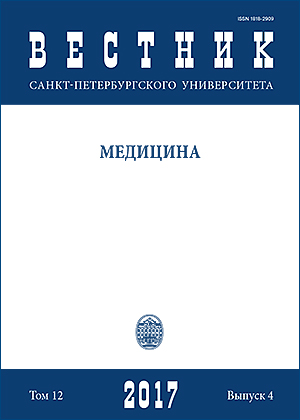МЕХАНИЗМЫ СНИЖЕНИЯ ТОЛЕРАНТНОСТИ К ФИЗИЧЕСКОЙ НАГРУЗКЕ У ПАЦИЕНТОВ С ХРОНИЧЕСКОЙ СЕРДЕЧНОЙ НЕДОСТАТОЧНОСТЬЮ
DOI:
https://doi.org/10.21638/11701/spbu11.2017.402Аннотация
Ключевые слова:
хроническая сердечная недостаточность, фракция выброса, одышка, мышечная слабость
Скачивания
Библиографические ссылки
References
patterns in chronic heart failure: relationship to exercise capacity.Eur. Heart J., 1992, vol. 13, pp. 749–757.
1995, vol. 26,pp. 429–435.
systolic velocity change during dobutamine stress echocardiography predicts contractile reserve and exercise tolerance in patients with heart failure. Eur. Heart J. Cardiovasc. Imaging, 2013, vol. 14, pp. 102–109.
C. Gas diffusion and alveolar-capillary unit in chronic heart failure. Eur. Heart J. 2006, vol. 27, pp. 2538–2543.
function and exercises gas exchange in chronic heart failure. Circulation, 1997, vol. 96, pp. 2221–2227.
oxide leading to pulmonale edema in stable severe heart failure. Am. J. Cardiol., 1994, vol. 74, pp. 70–72.
experimental model of chronic heart failure. Circ. Res., 1991, vol. 69, pp. 1088–1096.
of lung diffusing capacity following fluid withdrawal by ultrafiltration in chronic heart failure. J. Am. Coll.
Cardiol., 2000, vol. 36, pp. 1600–1604.
Am. Heart J., 1996, vol. 132, pp. 900–904.
humans. Respiratory physiology and neurobiology, 2011, vol. 178, no. 2, pp. 191–195.
the “muscle hypothesis” of exercise intolerance in chronic heart failure. Am. Heart J., 1999, vol. 137,
pp. 1050–1056.
failure. Current Pharmaceutical Design, 2008, vol. 14, pp. 2572–2581.
Hambrecht R. Functional and morphological skeletal muscle abnormalities correlate with reduced
electromyographic activity in chronic heart failure. Eur. J. Cardiovasc. Prev. Rehabil., 2004, vol. 11, no. 2,pp. 155–161.
exercise capacity to skeletal muscle characteristics in men with congestive HF. J. Am. Coll. Cardiol., 1996,vol. 27, pp. 140–145.
Carey M. F. Reduced exercise tolerance in CHF may be related to factors other than impaired skeletal muscle
oxidative capacity. J. Card. Failure, 2004, vol. 10, pp. 141–148.
Coats A. J. Hormonal changes and catabolic/anabolic imbalance in chronic heart failure and their importance
for cardiac cachexia.Circulation, 1997, vol. 96, pp. 526–534.
Tsagalou E. P., Nanas J. N. Hormonal profile in patients with congestive heart failure. Int. J. Cardiol., 2003,vol. 87, no. 2, pp. 179–183.
hemodynamics during exercise in patients with chronic heart failure. Circulation, 1989, vol. 80, pp. 769–781.
Brawner C. A., Blank J. M., Annex B. H. Capillary density of skeletal muscle: a contributing mechanism for
exercise intolerance in class II–III chronic heart failure independent of other peripheral alterations. J. Am.
Coll. Cardiol., 1999, vol. 33, pp. 1956–1963.
ventilatory inefficiency, and impaired autonomic control in heart failure. J. Heart Lung Transplant., 2011, vol. 30, no. 12, pp. 1403–1408.
in patients with heart failure and preserved left ventricular systolic function: failure of the Frank-Starling
mechanism. J. Am. Coll. Cardiol., 1991, vol. 17, pp. 1065–1072.
chronotropic and vasodilator reserves limit exercise capacity in patients with heart failure and a preserved
ejection fraction. Circulation, 2006, vol. 114, pp. 2138–2147.
fraction. Eur. J. Heart Fail., 2013, vol. 15, pp. 776–785.
Houstis N. E., Eisman A. S., Hough S. S., Lewis G. D. Mechanisms of exercise intolerance in heart failure with preserved ejection fraction. Circ. Heart Fail., 2015, vol. 8, pp. 286–294.
limit to aerobic capacity in patients with exertional pulmonary venous hypertension: implications for heart
failure with preserved ejection fraction. Circ. Heart Fail., 2015, vol. 8, pp. 278–285.
Skeletal muscle abnormalities and exercise intolerance in older patients with heart failure and preserved
ejection fraction. American Journal of Physiology. Heart and Circulatory Physiology, 2014, vol. 306, no. 9,pp. 1364–1370.
ejection fraction. Am. J. Cardiol., 2014, vol. 113, pp. 1211–1216.
Cardiol.,2010, vol. 56, no. 11, pp. 845–854.
Загрузки
Опубликован
Как цитировать
Выпуск
Раздел
Лицензия
Статьи журнала «Вестник Санкт-Петербургского университета. Медицина» находятся в открытом доступе и распространяются в соответствии с условиями Лицензионного Договора с Санкт-Петербургским государственным университетом, который бесплатно предоставляет авторам неограниченное распространение и самостоятельное архивирование.




